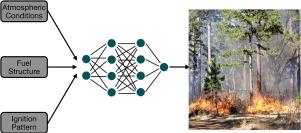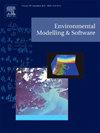Data-driven fire modeling: Learning first arrival times and model parameters with neural networks
IF 4.8
2区 环境科学与生态学
Q1 COMPUTER SCIENCE, INTERDISCIPLINARY APPLICATIONS
引用次数: 0
Abstract
Data-driven techniques are increasingly being applied to complement physics-based models in fire science. However, the lack of sufficiently large datasets continues to hinder the application of certain machine learning techniques. In this paper, we use simulated data to investigate the ability of neural networks to parameterize dynamics in fire science. In particular, we investigate neural networks that map five key parameters in fire spread to the first arrival time, and the corresponding inverse problem. By using simulated data, we are able to characterize the error, the required dataset size, and the convergence properties of these neural networks. For the inverse problem, we quantify the network’s sensitivity in estimating each of the key parameters. The findings demonstrate the potential of machine learning in fire science, highlight the challenges associated with limited dataset sizes, and quantify the sensitivity of neural networks to estimate key parameters governing fire spread dynamics.

数据驱动的火灾建模:利用神经网络学习首批到达时间和模型参数
在火灾科学中,数据驱动技术正越来越多地用于补充基于物理的模型。然而,由于缺乏足够大的数据集,某些机器学习技术的应用仍然受到阻碍。在本文中,我们使用模拟数据来研究神经网络对火灾科学中的动态参数进行参数化的能力。特别是,我们研究了将火灾蔓延中的五个关键参数映射到首次到达时间的神经网络,以及相应的逆问题。通过使用模拟数据,我们能够确定这些神经网络的误差、所需数据集大小和收敛特性。对于逆问题,我们量化了网络在估计每个关键参数时的灵敏度。研究结果证明了机器学习在火灾科学中的潜力,强调了与有限数据集规模相关的挑战,并量化了神经网络在估算火灾蔓延动态关键参数时的灵敏度。
本文章由计算机程序翻译,如有差异,请以英文原文为准。
求助全文
约1分钟内获得全文
求助全文
来源期刊

Environmental Modelling & Software
工程技术-工程:环境
CiteScore
9.30
自引率
8.20%
发文量
241
审稿时长
60 days
期刊介绍:
Environmental Modelling & Software publishes contributions, in the form of research articles, reviews and short communications, on recent advances in environmental modelling and/or software. The aim is to improve our capacity to represent, understand, predict or manage the behaviour of environmental systems at all practical scales, and to communicate those improvements to a wide scientific and professional audience.
 求助内容:
求助内容: 应助结果提醒方式:
应助结果提醒方式:


